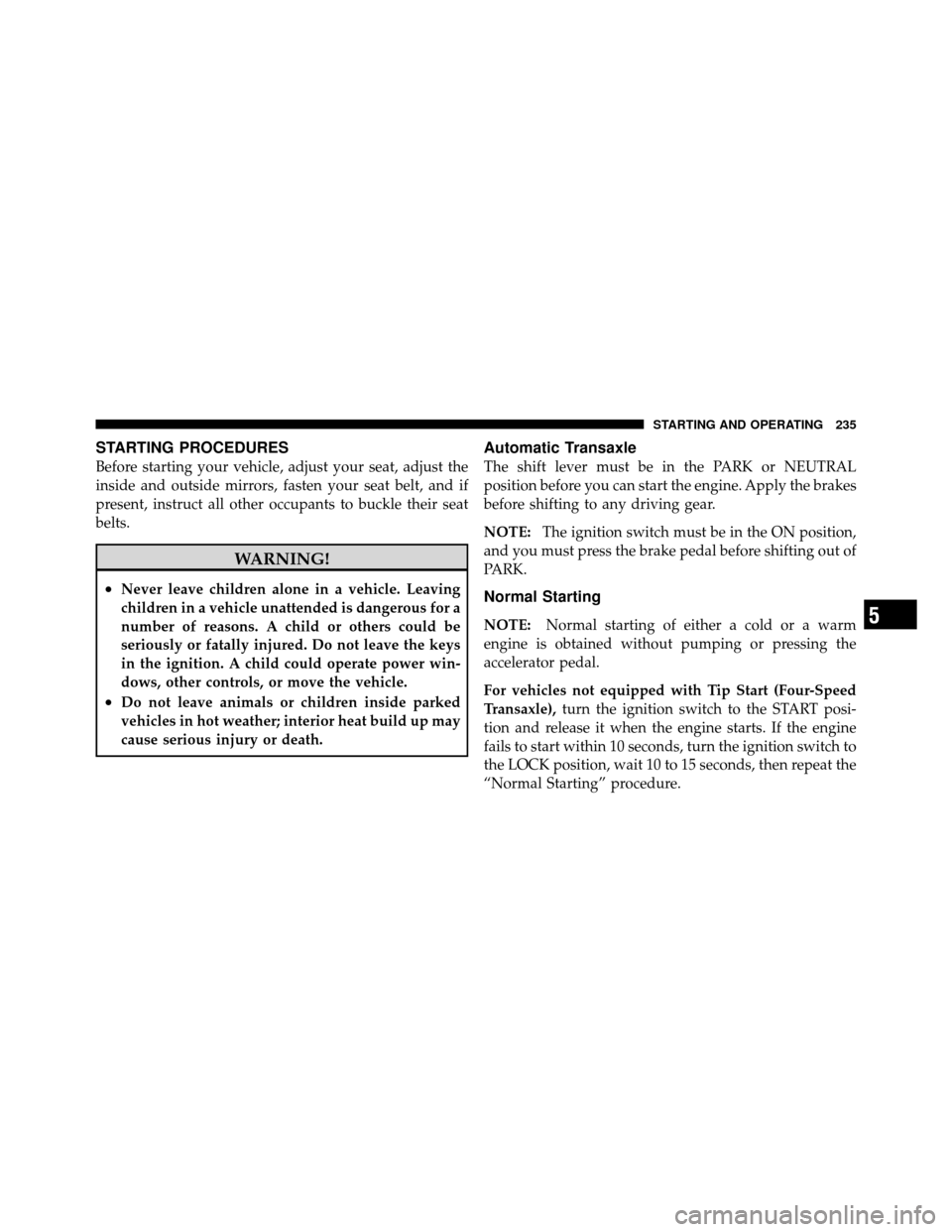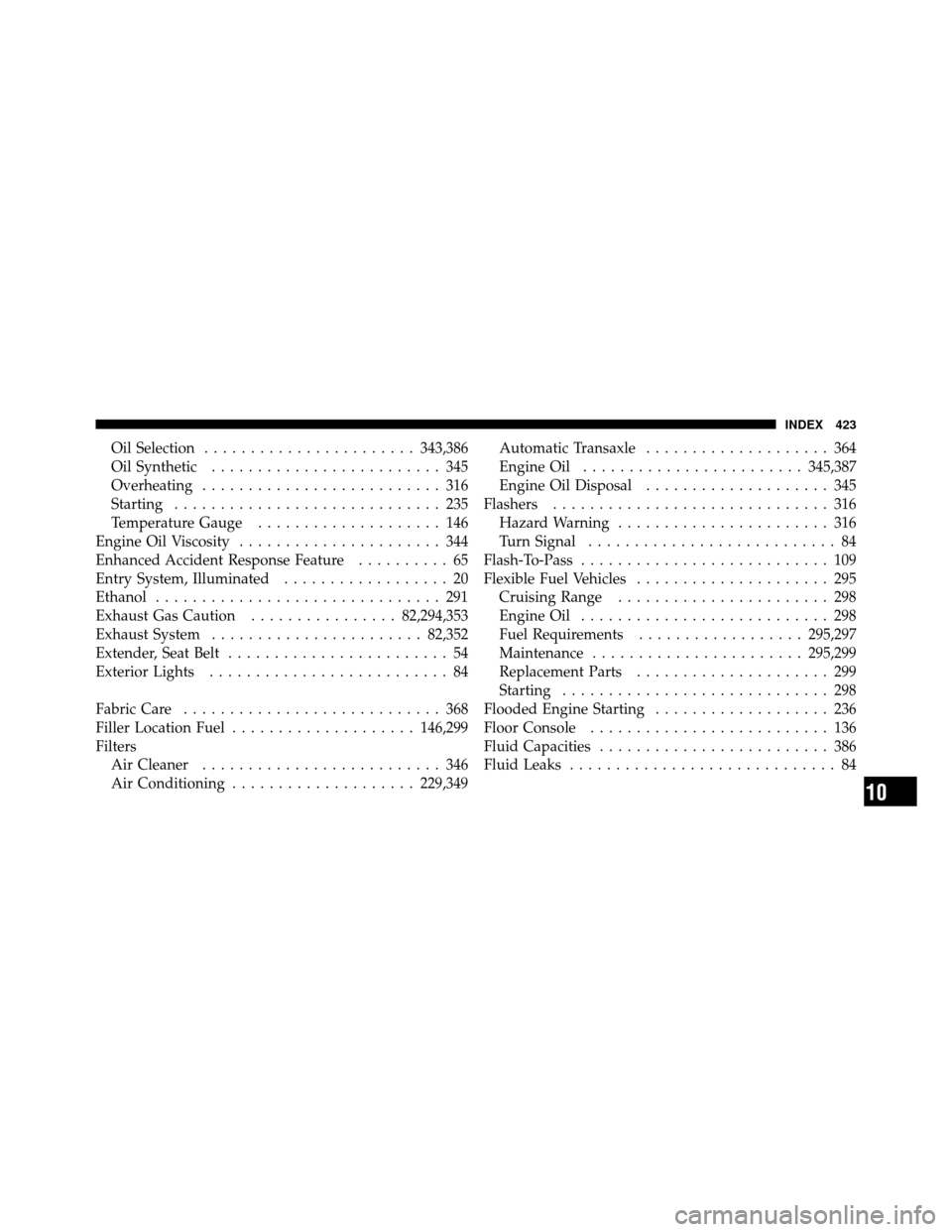2010 CHRYSLER SEBRING SEDAN belt
[x] Cancel search: beltPage 135 of 436

When the seatback is folded to the upright position, make
sure it is latched by strongly pulling on the top of the
seatback above the seat strap.
WARNING!
•Be certain that the seatback is securely locked into
position. If the seatback in not securely locked
into position, the seat will not provide the proper
stability for child seats and/or passengers. An
improperly latched seat could cause serious injury.
•The cargo area in the rear of the vehicle (with the
rear seatbacks in the locked-up or folded down
position) should not be used as a play area by
children when the vehicle is in motion. They could
be seriously injured in an accident. Children
should be seated and using the proper restraint
system.(Continued)
WARNING! (Continued)
•To help protect against personal injury, passengers
should not be seated in the rear cargo area. The
rear cargo space is intended for load carrying
purposes only, not for passengers, who should sit
in seats and use seat belts.
•The weight and position of cargo and passengers
can change the vehicle center of gravity and ve-
hicle handling. To avoid loss of control resulting
in personal injury, follow these guidelines for
loading your vehicle:
Always place cargo evenly on the cargo floor. Put heavier
objects as low and as far forward as possible.
Place as much cargo as possible in front of the rear axle.
Too much weight or improperly placed weight over or
behind the rear axle can cause the rear of the vehicle to
sway.
3
UNDERSTANDING THE FEATURES OF YOUR VEHICLE 135
Page 147 of 436

5. Low Fuel LightWhen the fuel level drops to approximately 2.0 gal-
lons (7.6 Liters), the fuel symbol will light and a
single chime will sound.
NOTE: This light will remain on until a minimum of
approximately 3.0 gallons of fuel is added.
6. Charging System Light This light shows the status of the electrical charg-
ing system. The light should come on briefly when
the ignition is first turned on and remain on briefly as a
bulb check. If the light stays on or comes on while
driving, turn off some of the vehicle’s electrical devices,
such as the Front Fog Lights or Rear Window Defroster.
If the Charging System Light remains on, it means that
the vehicle is experiencing a problem with the charging
system. Obtain SERVICE IMMEDIATELY. See your local
authorized dealer. If jump starting is required, refer to “Jump Starting
Procedures” in section 6 of this manual.
7. Airbag Warning Light
The light comes on and remains on for six to
eight seconds as a bulb check when the ignition
switch is first turned ON. If the light does not
turn on during starting, stays on, or turns on
while driving, have the system inspected by an autho-
rized dealer.
8. Seat Belt Reminder Light When the ignition switch is first turned ON, this
light will come on for about six seconds. A chime
will sound if you have not pulled the shoulder belt
out of the retractor. This is a reminder to “buckle up”. If
you do not buckle up, the light will remain on.
4
UNDERSTANDING YOUR INSTRUMENT PANEL 147
Page 235 of 436

STARTING PROCEDURES
Before starting your vehicle, adjust your seat, adjust the
inside and outside mirrors, fasten your seat belt, and if
present, instruct all other occupants to buckle their seat
belts.
WARNING!
•Never leave children alone in a vehicle. Leaving
children in a vehicle unattended is dangerous for a
number of reasons. A child or others could be
seriously or fatally injured. Do not leave the keys
in the ignition. A child could operate power win-
dows, other controls, or move the vehicle.
•Do not leave animals or children inside parked
vehicles in hot weather; interior heat build up may
cause serious injury or death.
Automatic Transaxle
The shift lever must be in the PARK or NEUTRAL
position before you can start the engine. Apply the brakes
before shifting to any driving gear.
NOTE:The ignition switch must be in the ON position,
and you must press the brake pedal before shifting out of
PARK.
Normal Starting
NOTE: Normal starting of either a cold or a warm
engine is obtained without pumping or pressing the
accelerator pedal.
For vehicles not equipped with Tip Start (Four-Speed
Transaxle), turn the ignition switch to the START posi-
tion and release it when the engine starts. If the engine
fails to start within 10 seconds, turn the ignition switch to
the LOCK position, wait 10 to 15 seconds, then repeat the
“Normal Starting” procedure.5
STARTING AND OPERATING 235
Page 328 of 436

7. Start the engine in the vehicle that has the booster
battery, let the engine idle a few minutes, and then start
the engine in the vehicle with the discharged battery.
8. When removing the jumper cables, reverse the se-
quence exactly. Be careful of the moving belts and fan.
9. Reinstall the protective cover over the remote jump-
start positive battery post.
NOTE:Refer to “Maintenance Procedures” in Section 7
of this manual for information on accessing the battery
for service or replacement.
WARNING!
Any procedure other than above could result in:
•Personal injury caused by electrolyte squirting out
the battery vent.
(Continued)
WARNING! (Continued)
•Personal injury or property damage due to battery
explosion.
CAUTION!
Any procedure other than above could result in
damage to the charging system of the booster vehicle
or of the immobilized vehicle.
FREEING A STUCK VEHICLE
If your vehicle becomes stuck in mud, sand, or snow, it
can often be moved by a rocking motion. Turn your
steering wheel right and left to clear the area around the
front wheels. Then shift back and forth between RE-
VERSE and FIRST gear. Using minimal accelerator pedal
pressure to maintain the rocking motion, without spin-
ning the wheels, is most effective.
328 WHAT TO DO IN EMERGENCIES
Page 370 of 436

Cleaning Plastic Instrument Cluster Lenses
The lenses in front of the instruments in this vehicle are
molded in clear plastic. When cleaning the lenses, care
must be taken to avoid scratching the plastic.
1. Clean with a wet, soft rag. A mild soap solution may
be used, but do not use high alcohol content or abrasive
cleaners. If soap is used, wipe clean with a clean damp
rag.
2. Dry with a soft tissue.
Seat Belt Maintenance
Do not bleach, dye, or clean the belts with chemical
solvents or abrasive cleaners. This will weaken the fabric.
Sun damage can also weaken the fabric.
If the belts need cleaning, use a mild soap solution or
lukewarm water. Do not remove the belts from the car to
wash them.Replace the belts if they appear frayed or worn or if the
buckles do not work properly.
Dry with a soft tissue.
Cleaning Center Console Cupholders
Removal
Grab the rubber portion of the cupholder and lift
upward.
Cleaning
Soak the rubber cupholder liner in a mixture of medium
hot tap water and one teaspoon of mild liquid dish soap.
Let soak for approximately one hour. After one hour pull
the liner from the water and dip it back into the water
about six times. This will loosen any remaining debris.
Rinse the liner thoroughly under warm running water.
Shake the excess water from the liner and dry the outer
surfaces with a clean soft cloth.
370 MAINTAINING YOUR VEHICLE
Page 401 of 436

102,000 Miles (170,000 km) or
102 Months Maintenance
Service Schedule
❏Change the engine oil and engine oil
filter.
❏ Rotate tires.
❏ Replace the spark plugs (2.4L PZEV*,
2.7L and 3.5L Engines).
❏ Replace the timing belt (3.5L Engine).
❏ Flush and replace the engine coolant.
❏ Inspect accessory drive belt, replace if
necessary.
Odometer Reading Date
Repair Order #Dealer Code
Signature Authorized Chrysler Dealer
108,000 Miles (180,000 km) or 108 Months Maintenance Service
Schedule
❏Change the engine oil and engine oil filter.
❏ Rotate tires.
❏ If using your vehicle in dusty or off-road conditions, inspect the engine air cleaner filter, and
replace if necessary.
❏ Inspect the brake linings, and replace as necessary.
❏ Replace the air conditioning filter (if equipped).
❏ Inspect the front suspension, tie rod ends and boot seals for cracks or leaks and all parts for
damage, wear, improper looseness or end play; replace if necessary.
Odometer Reading Date
Repair Order #Dealer Code
Signature Authorized Chrysler Dealer
8
M
A I
N T
E
N A
N CE
S
C
H E
D
U L
E
SMAINTENANCE SCHEDULES 401
Page 419 of 436

Automatic Transaxle..............12,235,239,362
Adding Fluid ................... 363,364,388
Filter ............................... 364
Fluid and Filter Changes ................. 364
Fluid Level Check ................... 363,364
Interlock System .................... 240,241
Reset Mode .......................... 245
Selection Of Lubricant ................... 388
Shifting ............................. 239
Special Additives ...................... 364
Autostick ............................. 246
Back-Up Lights ......................... 381
Battery ............................... 346
Gas Caution .......................... 347
Jump Starting ......................... 29
Keyless Transmitter Replacement (RKE) ....... 25
Location ............................ 346
Belts, Seat .............................. 83 Body Mechanism Lubrication
............... 350
B-Pillar Location ........................ 268
Brake Assist System ...................... 257
Brake, Parking .......................... 252
Brake System ........................... 360
Anti-Lock (ABS) ....................... 254
Fluid Check ....................... 360,388
Master Cylinder ....................... 360
Parking ............................. 252
Warning Light ........................ 148
Brakes ............................... 360
Brake/Transaxle Interlock .................. 240
Break-In Recommendations, New Vehicle ........ 81
Bulb Replacement ....................... 377
Bulbs, Light .......................... 84,377
Calibration, Compass ..................... 165
Capacities, Antifreeze (Engine Coolant) ......... 20
Capacities, Fluid ........................ 386
10
INDEX 419
Page 423 of 436

Oil Selection....................... 343,386
Oil Synthetic ......................... 345
Overheating .......................... 316
Starting ............................. 235
Temperature Gauge .................... 146
Engine Oil Viscosity ...................... 344
Enhanced Accident Response Feature .......... 65
Entry System, Illuminated .................. 20
Ethanol ............................... 291
Exhaust Gas Caution ................82,294,353
Exhaust System ....................... 82,352
Extender, Seat Belt ........................ 54
Exterior Lights .......................... 84
Fabric Care ............................ 368
Filler Location Fuel .................... 146,299
Filters Air Cleaner .......................... 346
Air Conditioning .................... 229,349Automatic Transaxle
.................... 364
Engine Oil ........................ 345,387
Engine Oil Disposal .................... 345
Flashers .............................. 316
Hazard Warning ....................... 316
Turn Signal ........................... 84
Flash-To-Pass ........................... 109
Flexible Fuel Vehicles ..................... 295
Cruising Range ....................... 298
Engine Oil ........................... 298
Fuel Requirements .................. 295,297
Maintenance ....................... 295,299
Replacement Parts ..................... 299
Starting ............................. 298
Flooded Engine Starting ................... 236
Floor Console .......................... 136
Fluid Capacities ......................... 386
Fluid Leaks ............................. 84
10
INDEX 423